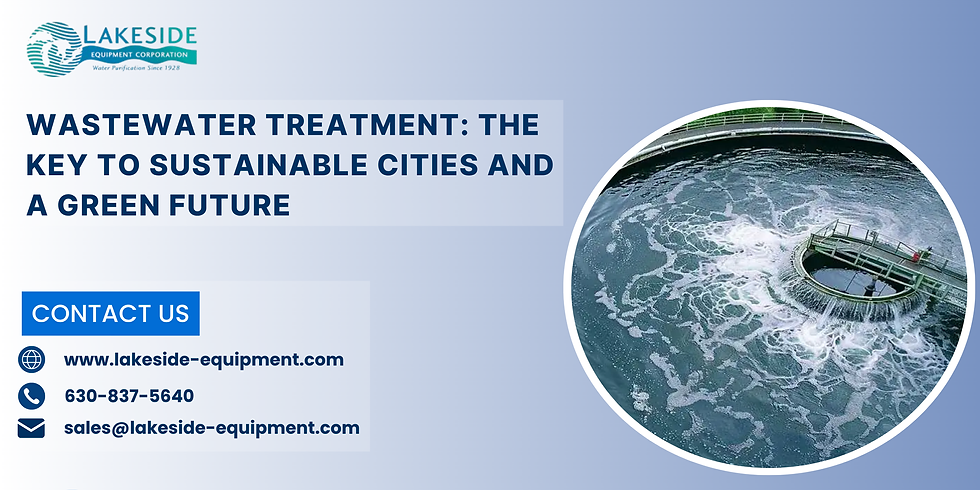Eco-Friendly Wastewater Treatment Solutions You Should Know
- lakesideequipment

- Sep 25
- 4 min read
With global water scarcity growing and environmental regulations being strengthened. The need for green wastewater treatment technologies has never been greater. Conventional technologies, which may seem effective, consume large amounts of energy and chemicals with a lasting environmental footprint. A wave of innovation, however, is transforming the way wastewater is treated, thus making it a cleaner, greener, and more resilient option.
In this post, we will detect the latest successes in wastewater treatment, the role of advanced systems such as Duperon Flexrake, in pay special attention to wastewater screening technologies and running eco-efficiency.

Why Wastewater Treatment Needs Innovation?
Wastewater treatment is important in the protection of public health and the natural environment. This forces the removal of pollutants from sewage and industrial wastes before reusing water for various loops or removing pollutants.
Nevertheless, traditional treatment features use energy-opening processes and chemical additives that are harmful to aquatic organisms and contribute to greenhouse gas emissions. With stability at the forefront of priorities for industries and municipalities, it is now focused on green technologies that reduce environmental footprints without compromising high standards of treatment.
The Rise of Green Technologies in Wastewater Treatment
Today's wastewater treatment is evolving in fascinating directions. Some of the most breathtaking sustainable innovations are as follows:
Improvements in Biological Treatment: Emerging biological technologies such as membrane bioreactors (MBRs) and moving bed biofilm reactors (MBBRs) are enhancing organic matter degradation. Naturally occurring microorganisms are utilized by these technologies to degrade wastewater with low chemical inputs.
Energy Recovery System: Some treatment plants currently recover energy from waste water. For example, anaerobic digestion produces biogas, mud, which is used to supply power to the plant, transforming waste into a renewable energy source.
Water recycling and reuse: In some parts of the world, more treated sewage is being recycled for drinking water at irrigation purposes, industrial cooling purposes, and fast speed is being recycled. It reduces the requirement for freshwater resources and supports circular water management.
Low-Energy Filtration Technology: Emerging filtration technology, such as ceramic membranes and gravity membrane systems, is of high performance with reduced energy needs over traditional technologies.
Wastewater Screening: The First Line of Defense
Before biological or chemical treatment, wastewater is screened to remove large solids and debris. This step, known as wastewater screening, is necessary in an effort not to ruin equipment that is downstream, as well as to preserve the effectiveness of the overall treatment process.
There are sustainable screening technologies that can run with infrequent maintenance, reduced power costs, and minimal breakage. A good example of such is the Duperon Flexrake.
Spotlight on the Duperon Flexrake
The Duperon Flexrake is a cutting-edge screening system that has revolutionized primary wastewater treatment in facilities. Compared to traditional bar screens that require frequent cleaning by hand and clogging, the Flexrake has an automated and self-sweeping feature that is cost-effective and environmentally friendly.
Key Features:
Continuous cleaning mechanisms: Flexrake uses a series of flexible stainless-steel scrapers to sweep the screen without an external brush or spray.
Use of low energy: Since it is a simple mechanical design, the use of energy is kept to a least, and therefore is well suited to buildings that aim to reduce their carbon footprint.
Reliability and durability: Withstanding the harsh environment, Flexrake degrades extremely slowly and has minimal downtime and maintenance.
Versatility: It may be mounted with a variable channel width and depth, making it a good fit for municipal, industrial, and agricultural use.
Through the incorporation of the Duperon Flexrake into the wastewater screening system, operating efficiency can be greatly enhanced by the treatment plant to meet stability objectives.
Real-World Application: Green Screening in Action
Duperon Flexrake has already been installed in cities and factories around the world with remarkable results. For example:
A wastewater treatment plant in Michigan decreased maintenance costs by 30% after it adopted the use of the Flexrake system.
One California plant listed more effective screening and lower energy usage as part of its LEED certification project.
Industrial customers noted that the Flexrake is effective at transporting great volumes of trash without plugging, which is essential in mission-critical uses where waste streams vary.
These case histories demonstrate the way smart screening products contribute to developing real-world gains in environmental performance and operational economics.
The Future of Wastewater Treatment: Intelligent, Sustainable, and Scalable
Climate change and a growing population give way to the future of increasing demands, and wastewater treatment calls on the water supply, thus necessitating clever, scalable, and durable technologies. Innovations like Duperon Flexrake are just the beginning.
The paths of the new future are:
Artificial intelligence-monitoring systems for real-time optimization of treatment processes.
Decentralized treatment modules for rural and remote locations.
Green infrastructure integration, such as wetlands and biofilters.
These technologies are to make wastewater treatment more viable, efficient, and environmentally friendly.
Final Thought
Sustainable wastewater treatment technologies are not only about regulation. They are about creating a permanent, healthy environment and healthy communities. From advanced biological treatment systems to intelligent wastewater screening techniques such as Duperon Flexrake, focusing on industry performance-balanced, permanent solutions.
Whether you work as a municipal planner, an industrial operator, or an environmentalist, you must be informed of these innovations if you wish to bring about good change. The tools are available. The technology is available. The time to act is now.




Comments